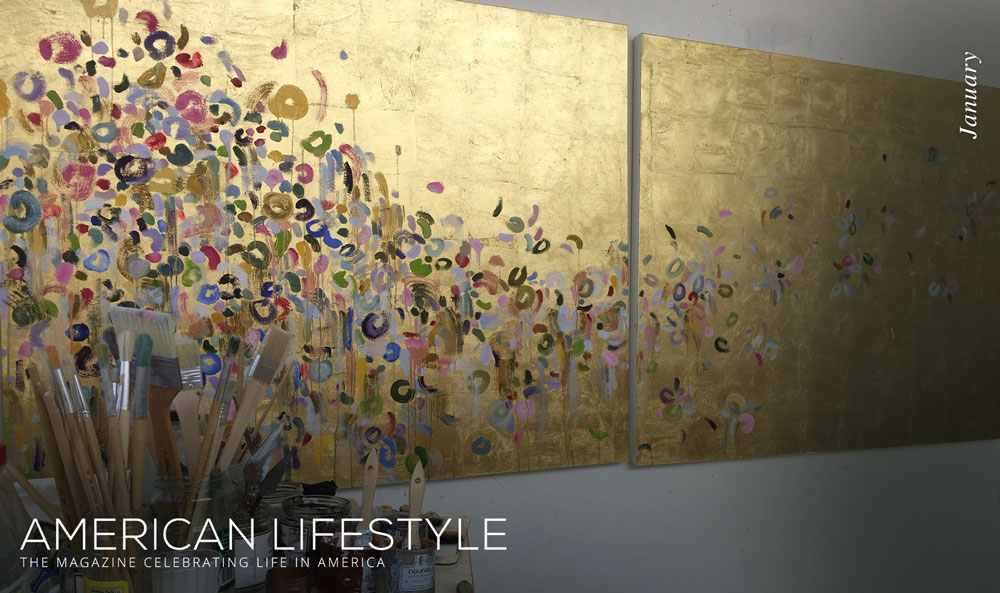January marks the turning of a page, meaning it’s time to embrace the new year with a fresh perspective and innovative ideas. Consider this issue of American Lifestyle your guide to starting 2025 on a high note. Inside, you’ll discover tips for forming good organizational habits, a look into one artist’s luminous creations, two veggie-packed Italian dishes, and the best places to take a warm-weather escape.
If you’re hoping to clear the clutter out of your life this year, read about some creative strategies that can bring fresh clarity and order. From tidying up your home to managing your time to building financial wellness, these tips can help you set the stage for a well-organized and positive 2025.
Artist Michelle Sakhai is known for her unique approach to incorporating metal leaf into her paintings, which adds a touch of brilliance to each one. The enclosed article offers a glimpse into her signature style as well as her creative process and the experiences that shaped her art.
Transport the warmth of Italy into your kitchen with two timeless dishes that promise to create unforgettable meals. These recipes for spinach and polenta soup and peperonata with eggplant and tomato can both enhance your dining experiences and bring loved ones together around the table.
If the winter blues are getting you down, discover six destinations that make for the ideal warm-weather retreat. Whether you're looking for a beach getaway or exciting nightlife, these options provide a perfect escape from the cold, helping you unwind and recharge.
Here’s to a promising start to the year filled with fresh inspirations and joyful experiences! As always, it’s a pleasure to send you this magazine.
The new year serves as a natural blank canvas, providing an opportunity for new behaviors to blossom and old ones to shed. And one of the best ways to begin this next chapter is to organize yourself and the environment around you. Research indicates that mess can raise stress and induce anxiety, while clearing it may improve your mental health along with your work and personal relationships. Discover simple ways to remove the clutter from all areas of your life so you can march into the future with a healthier outlook.

A well-organized life is formed from habits, so focus on establishing routines, whether it’s weekly meal-planning sessions, a morning meditation practice, or an evening cleaning ritual. This can help provide structure and predictability, simplify daily tasks, and lessen decision fatigue; the more decisions you have to make, the more your mental energy becomes depleted. Consistency is key here—it can take anywhere from one to six months (or even longer) to form a new habit depending on what it is. This may mean giving more deliberate effort in the beginning, but if you stick with it, you’ll eventually develop positive routines that can ultimately create more ease in your day-to-day.

Given that time is our most valuable resource, good time management is crucial to great organization. Digital calendars and task-tracking apps like Todoist are among the slew of valuable tools available to help you take charge of your hours. Other solutions include time blocking, or allocating specific chunks of time for various tasks, and the Pomodoro Technique, which involves doing short bursts of concentrated work followed by breaks. The former may enable you to better stay on top of your to-do list, while the latter may offer a boost to your concentration and productivity.

A messy space may often reflect a messy mind. To help clear this clutter, take some time to neaten up your living spaces for a calmer environment.
Clean out
Working room by room, go through every item to determine which ones may not be conducive to an organized area. For help discerning what’s a keeper and what’s expendable, consider the KonMari Method, a popular approach that promotes throwing away anything that does not “spark joy.” Ask yourself if that old, tattered sweater still makes you happy or if that gift your coworker gave you has been helpful. If the answer is no to any item, then go ahead and donate, recycle, or throw it out.
Store items
Once you’ve whittled down your belongings, make useful investments in storage options to stow them in an aesthetically pleasing way. From vibrant baskets to simple, elegant containers, these vessels will help you clear messy areas by giving everything its place. And don’t forget to take advantage of vertical space with pegboards, shelves, and hooks. However you prefer your storage, consistent maintenance is vital to a clean abode, so regularly plan decluttering sessions every few weeks to keep your spaces neat and tidy.

Although technology is a valuable tool, it can also be a source of disarray and disorganization. Psychology Today notes that too much use of it can cause feelings of anxiety, loneliness, and isolation, leading you to feel less in control of your daily to-do list and relationships. One way to help combat this is with digital organization. Consider eliminating seldomly used apps, unsubscribing from certain marketing emails, and keeping your workstation, whether at home or in the office, free from electronic distractions. You may even want to set aside particular hours for online use and designate tech-free areas inside your house.

Though often neglected, financial organization is a pillar of general well-being and will make you more able to reach your long-term goals. First compile all your financial records, then decide on a system to keep everything easily accessible; you could use digital tools that track income and expenses, spot spending trends, and help you stick to a budget. Also consider automating your savings contributions and bill payments, which can streamline your monthly financial task list and allow you to avoid the stress of having to stay on top of all your expenses. And don’t forget to review your subscriptions and memberships—cancelling any you don’t use will mean fewer costs you have to remember to track.

Nothing can make your life feel messy like your work bleeding into your personal time; if you aren’t able to find a healthy work-life balance, it could cause other areas in your life to suffer and unwanted disarray to manifest. To better prevent this, clearly define the lines separating your home life from your career, whether this be with yourself, your family, or your colleagues. Set a hard end time for your workday, commit to not checking emails after hours, and let others know about your boundaries. And if you work remote, create a specific area where you focus only on work-related tasks. Making a clear distinction between work and home can be a rewarding way to ensure a more orderly life.
Organization is an ever-evolving task. The secret is to find routines and systems that fit your personality and lifestyle. Keep in mind that progress—not perfection—is the focus here. So begin 2025 by creating stepping stones that can lead to a productive and fulfilling year ahead.
“Painting is the process of self-discovery.”
–Michelle Sakhai
Michelle Sakhai, a contemporary expressionist artist, discusses her creative process and what led her to incorporate gold and silver leaf into her artwork, becoming a pioneer in the medium.
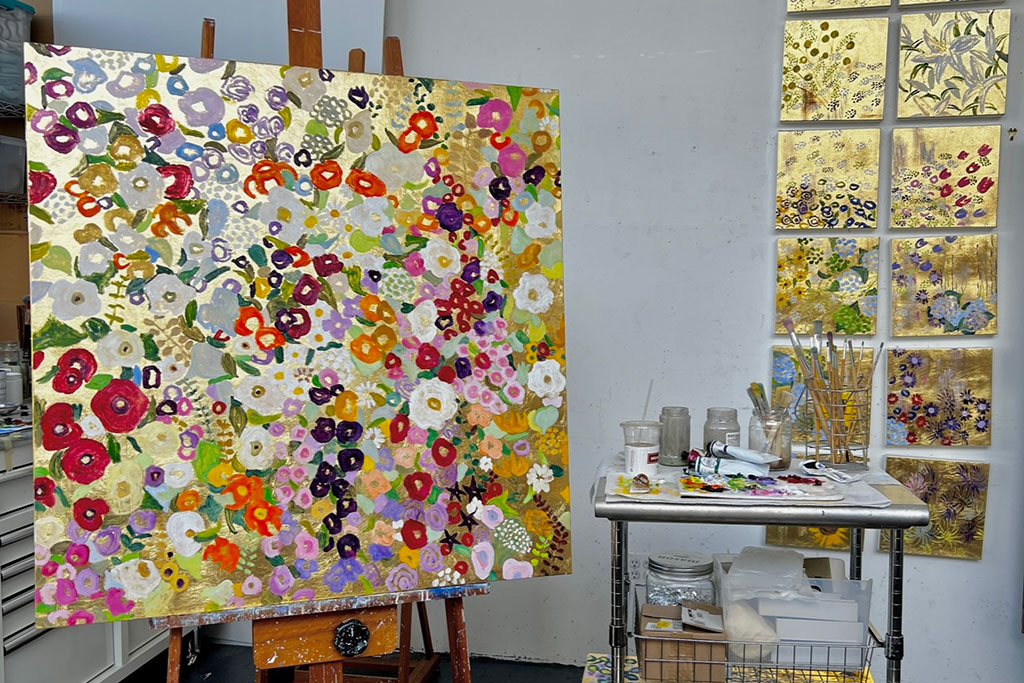
Tell us about yourself and how you first became interested in art:
My family has always valued creativity and self-expression, so my interest in art started at a young age. As soon as I was able to hold a brush, I began painting and couldn’t stop, and I quickly realized that being a creator was an intrinsic part of me. Being half-Japanese and half-Iranian, my artistic identity is deeply intertwined with my mixed heritage, which has fueled my creative vision and artistic style. The cultures are quite different from each other but equally rich and impactful, so I’m grateful to have the vibrancy and individuality of both.
How specifically has your heritage influenced your work?
I was born and raised in New York, but growing up, I spent my summers visiting my grandparents in Kashiwazaki, Japan. For three months out of the year, I was immersed in the local culture and attended Japanese school, and we would also go on sailing adventures. All these experiences instilled in me a profound appreciation of the simplicity and depth of Japanese art and life.
While there, I also encountered historic Japanese zen paintings and shoji screens, which have gold leaf incorporated into their designs. Those always resonated with me because I found the gold to be powerful yet simplistic. Although I organically shifted to using gold and silver leaf on my own later in life, I know growing up around those designs had a deep impact on me and the evolution of my art.

How has your art changed throughout your life?
When I was thirteen, I transitioned from watercolors to oils. Then in high school, I became a landscape artist and painted en plein air, which is a French term meaning “in the open air”; I would basically take my paints with me wherever I went. I also began selling my work during that time. Following graduation, I studied abroad at a few different art schools in Barcelona, Spain, and Aix-en-Provence, France, where I continued painting outdoors and focused on the impressionistic style of painting.
After graduating from Hofstra University and later earning a master of fine arts from the Academy of Art University, my work slowly evolved, becoming less impressionistic and more abstract. I turned inward and became my own muse rather than searching for an outside subject. This was around the time I started incorporating gold leaf in my art. Working with it adds a unique dimension and reflective element to my paintings, creating a luminous and ethereal quality that brings together the old and the new. I love how a painting transforms with the changing light throughout the day—it never looks the same. I now include metal leaf in all my paintings, and it’s become what I’m known for.
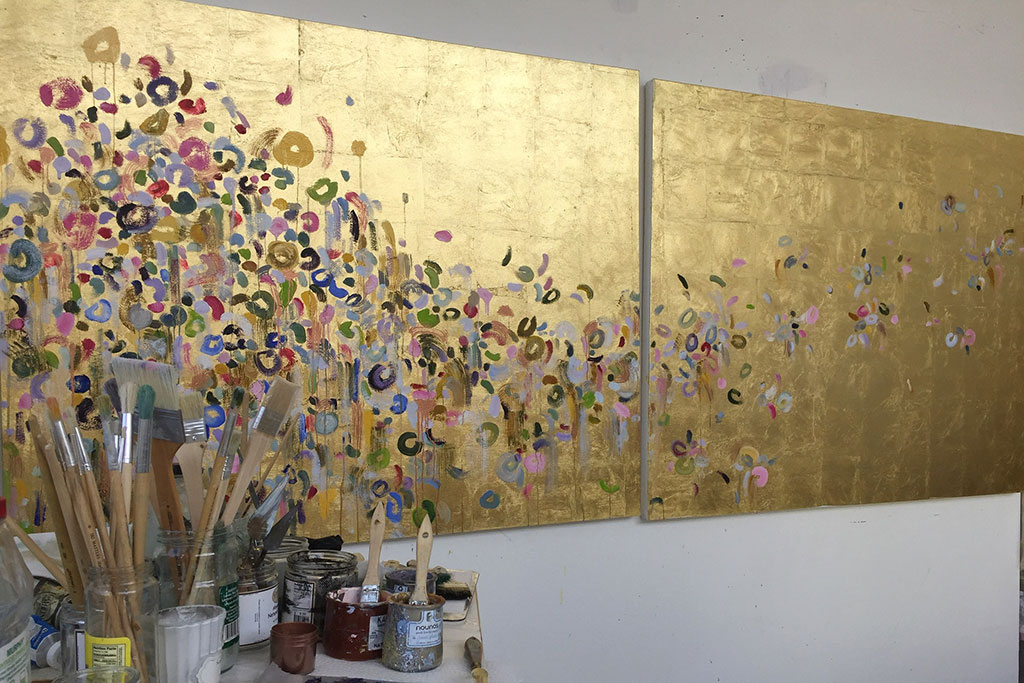
Walk us through your creative process:
I begin with meditation, which allows me to better connect with my inner emotions. Before painting, I always have my canvases prepared, meaning I have already layered them with gold or silver leaf. This often takes me days to complete since I brush each leaf square onto the canvas one by one; it’s a long and sensitive process since the material is extremely fragile and can fall apart at any moment.
I will sometimes have a concept in mind of what I’d like to paint, but that mostly serves as a guide rather than a strict plan. More often than not, the painting evolves naturally as I let each stroke guide me to the next one. I like working with texture and constantly keep in mind the negative space of the metal leaf because it’s just as important to me as the paint strokes themselves.
What inspires you?
Living inspires me. I know that may sound cliché, but it’s true. All the suffering and all the joy that comes with living a human experience fuels my work. I paint from a soul level, and there’s really no right or wrong; each expression of emotion just is. By exposing my most vulnerable self in my creations, I want to dissolve the boundaries that separate us. My hope is that people who encounter my work will better connect with their own inner consciousness.

Tell us about some of your past and current exhibits:
My work has found homes in museums, private residences, galleries, universities, and institutions such as Montefiore Medical Center in New York. I also enjoy exhibiting in hotels since I find them to be the most interactive; for instance, I’ve appeared in the Fairmont Hotel in San Francisco and the Miraval Resort & Spa in the Berkshires and Arizona as well as abroad at the Kamakura Park Hotel in Japan and El Hotel Pacha in Ibiza. And I had a solo exhibition in Korea at the Space776 gallery in Gangnam-gu, Seoul, last year. It was exciting since it was my first time showing there.
Beyond that, I recently exhibited in a new designer showroom in Cape Cod through KW Contemporary Art in Maine, where I have an ongoing show. Additionally, my work is displayed at Monica Graham Fine Art in Carmel-by-the-Sea, California, and the Patrick Jones Gallery in Houston, Texas.
For more info, visit michellesakhai.com
Nothing staves off winter’s chill like the warmth of a family kitchen filled with dishes fine-tuned over generations. Using fresh ingredients simmered with love, these two recipes from the At Nonna’s Table cookbook capture this very essence, offering a taste of tradition to pair perfectly with heartfelt gatherings.
Simple yet satisfying, this soup is packed with leafy greens and comforting grains.
This dish brings the brightness of summer amid winter’s colder weather with its flavorful mix of fresh vegetables.
Excerpted from At Nonna’s Table by Paola Bacchia, published by Smith Street Books, 2024. Photography by © Paola Bacchia.
recipe by paola bacchia
photos by paola bacchia
The recipe for spinach and polenta soup is from Friuli–Venezia Giulia, the region in north-east Italy where Mamma’s family moved after they left the Veneto. It is simple but surprisingly hearty. The dish can be enhanced by crumbling in a couple of pork sausages—or even some finely chopped pancetta—at the start, and/or replacing the vegetable stock with a homemade meat stock. The addition of parmesan is not traditional, but adds a lovely creamy and salty edge, and is my preferred way to enjoy this thick, rustic soup.
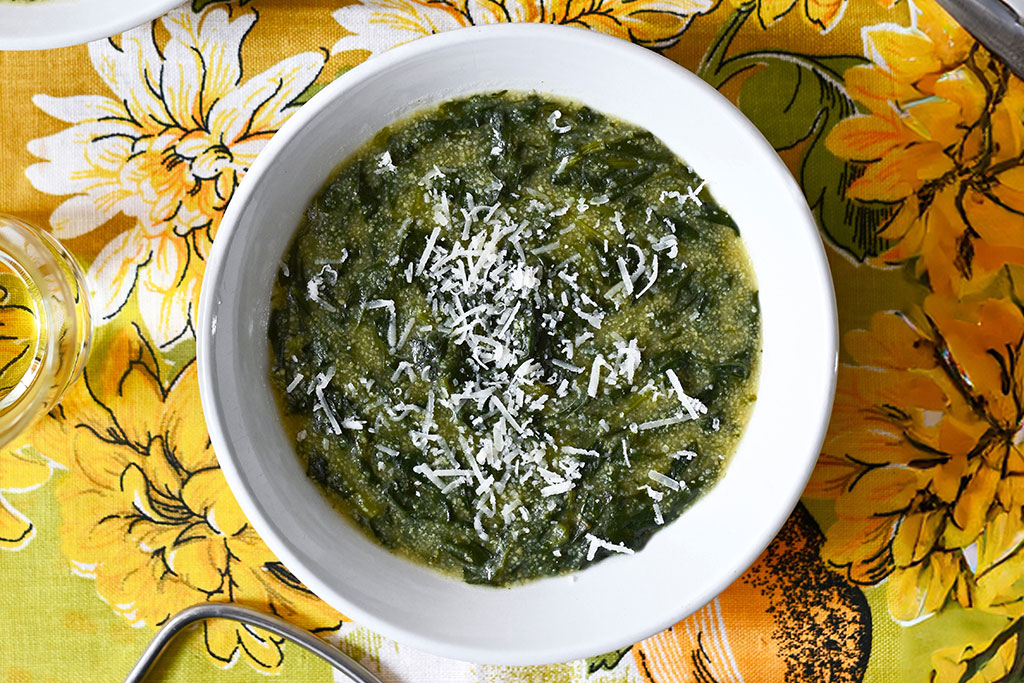
Serves 6–8
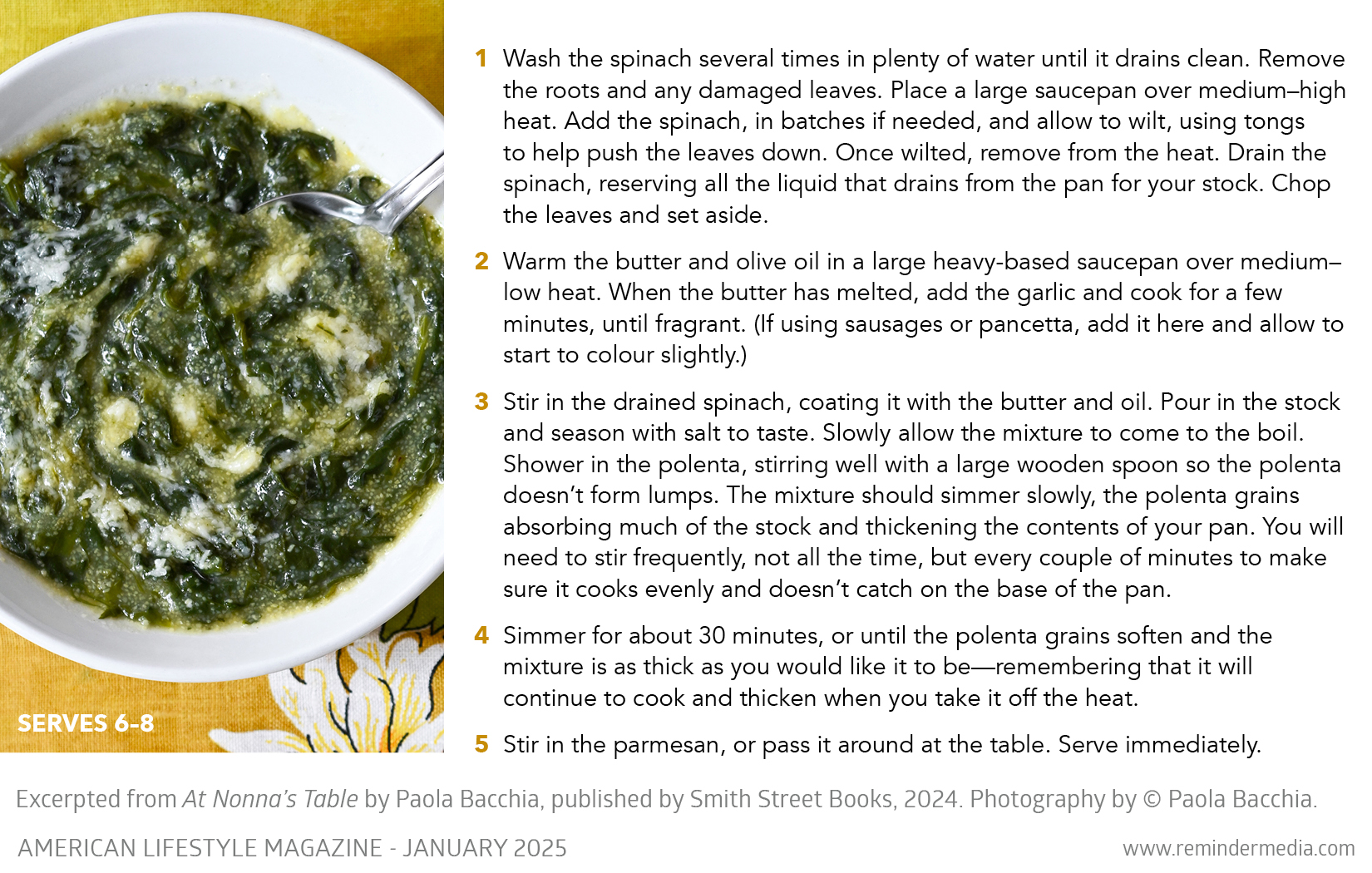

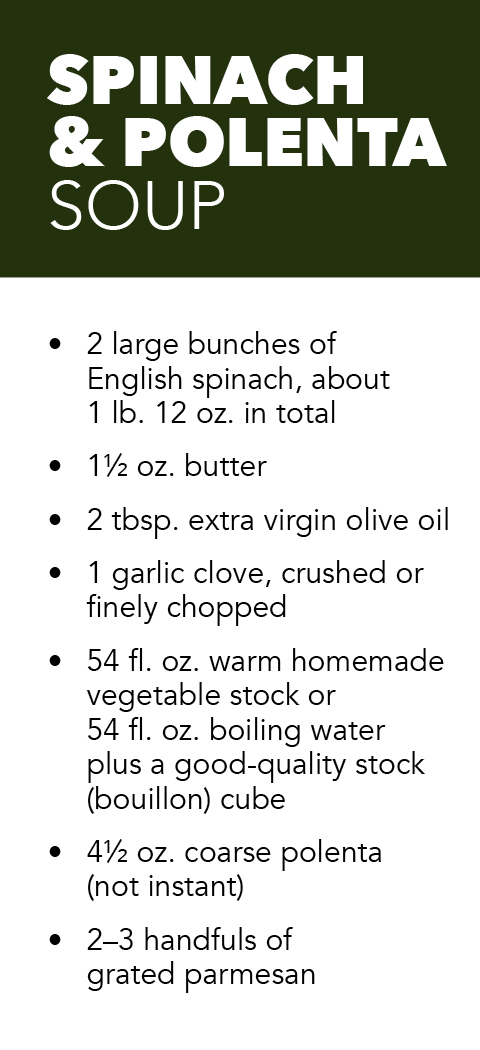
recipe by paola bacchia
photos by paola bacchia
In the past, eggplant was salted before using to remove bitterness—though most eggplants sold by greengrocers these days are not really bitter. That said, I still salt the diced eggplant for this recipe, as I find it is a great way of seasoning the dish. It does take some time, so feel free to omit this step.
This dish makes a main meal for vegetarians, a substantial side dish, and can also be used as a base for a couple of batches of pasta. It can also be halved and used in a risotto for four people.

Serves 6–8 as a side
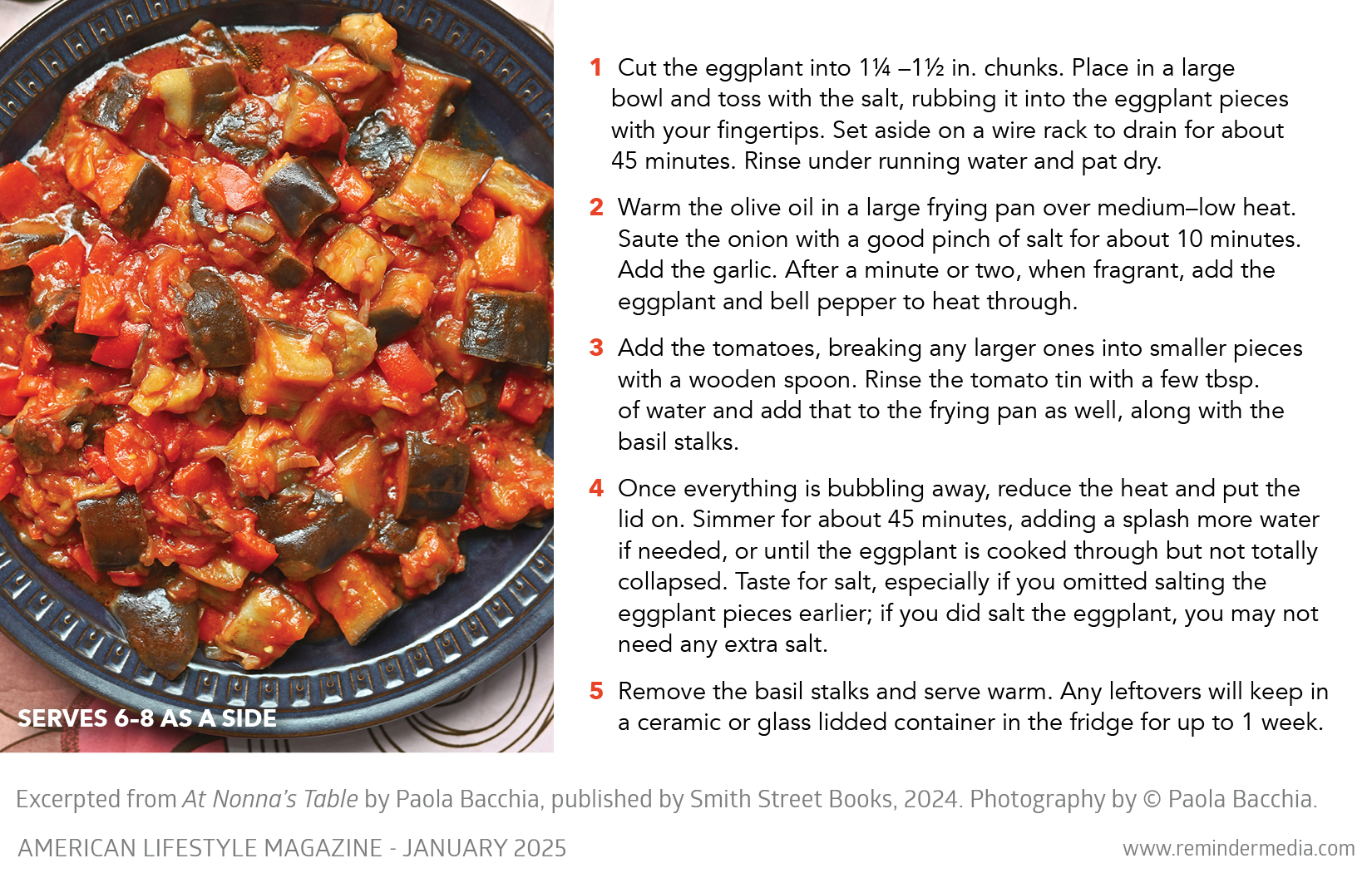

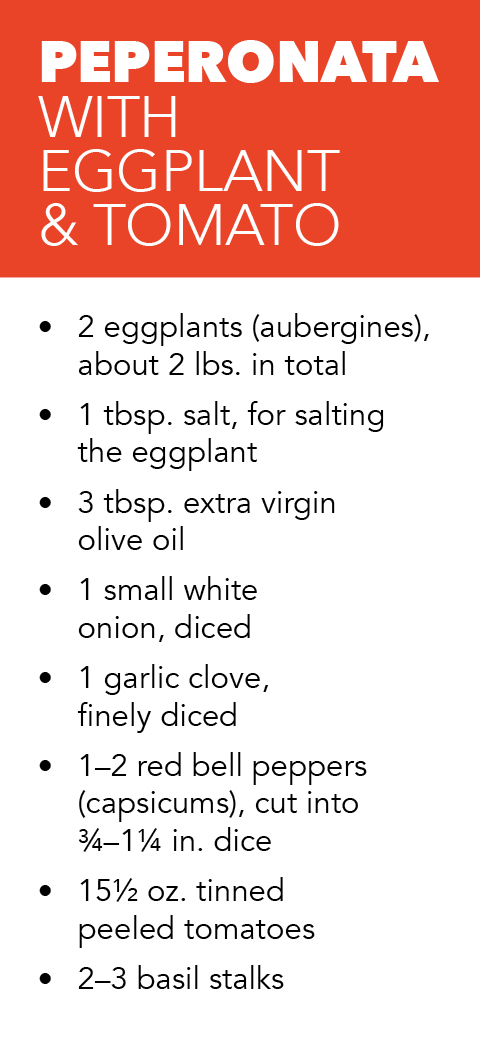
After the joy of the holidays, winter can quickly begin to feel like it’s outstaying its welcome, blanketing your days in gloomy conditions and bringing temperatures that make you shiver. But in some parts of the country, cold weather is just a theory. Rather than bundling up indoors to wait out the season, book an impulsive getaway to one of these six jovial destinations, where you can flee its chilling effects and celebrate some offseason sunny vibes.

Known as the neon city, this town of endless merrymaking is practically built for tourism. Besides its glittering casinos, Las Vegas boasts multiple family-friendly activities. Sightsee along the famous Strip to catch glimpses of landmarks like the replica Eiffel Tower, the Fountains of Bellagio, and the Sphere, an innovative new entertainment venue. Or stop by one-of-a-kind institutions such as the Neon Museum, featuring a boneyard of vintage signs, and Omega Mart, an odd grocery store with a host of alien-like art forms.
And did you know that Las Vegas’s spectacle of lights makes it the brightest place on Earth from outer space? Though you can’t witness this effect for yourself, you can get some air at any of the observation decks in the STRAT’s tower—the tallest view tower in the United States.
Depending on what you’re used to, winter may seem relatively mild here, dropping only into the high thirties at night with occasional rain. But even so, Las Vegas is a city best enjoyed indoors to the soundtrack of thrown dice, shaken ice, and carefree laughter.

It’s no surprise that one of America’s southernmost locales has slotted an appearance on this list. This iconic retreat is beloved for its flamboyant beaches, Art Deco architecture, skyline of grand waterfront condos, and vibrant Cuban-inspired cuisine.
Though the sand and surf will have a noticeable chill—with typical winter lows dipping to a reasonable 63 degrees—beach walks this time of year are still sure to be peaceful and refreshing. You can listen to the wind rustling the palm trees and the waves crashing on the shore without the usual hustle and bustle of hot-season tourists. And there’s plenty of indoor fun to indulge in as well, including at attractions like the renowned Bass Museum of Art and the Frost Museum of Science’s aquarium and planetarium. Delight in these institutions all day, then return to the beach for unforgettable orange sunsets, piña colada in hand.

This city whirs with life year-round, even outside the seasonal swarm that is Mardi Gras. Bourbon Street’s boisterous nightclubs and bars are certainly a popular draw, but there’s much more that makes the Big Easy special. Stroll down the streets of the French Quarter, the city’s oldest neighborhood, to appreciate French architecture, including the famous St. Louis Cathedral; enjoy shopping and museums within footsteps of Spanish Plaza; and catch live music in venues that line the maze-like Creole corridors of the Marigny district. And, of course, you can’t miss the experience of watching steamboats mosey down the Mississippi River, preferably with a warm, sugary beignet in hand.
If all this sightseeing on foot quickens you to question the weather, don’t fret: New Orleans enjoys winter days as warm as about 64 degrees. Not that the city lacks its chills—you may find yourself with goosebumps if you bravely venture into any of its many haunted attractions, including St. Roch’s cemeteries.

A lively tropical island, Puerto Rico is one of America’s sunniest getaways and also among the most exotic. But don’t let its compact size fool you; it conceals fantastic charms unlike anything else on the mainland. Here you’ll find crystalline Caribbean beaches, vibrant customary dishes that feature tropical produce like plantains and yuca, and a unique blend of historic architecture ranging from imposing fortresses to multicolored corridors.
Best of all, temperatures only descend into the seventies at the lowest—no wonder many locals boast that “there is no winter” in Puerto Rico. In fact, this may be the best season to visit some of the island’s most iconic coastal sites, such as the capital city of San Juan and the beaches of Playa Aviones. And make sure to venture inland as well for must-sees including El Yunque rainforest, where tropical conditions reign all year.

While the sunny state of California is practically synonymous with surfboards and beach balls, San Diego’s southern position makes it a particularly optimal retreat from any signs of winter. Wander by day under stellar palm trees at Balboa Park, a collection of museums and manicured gardens featuring gorgeous Spanish Colonial Revival architecture. Then after sundown, head to the historic Gaslamp Quarter to explore its vibrant galleries, restaurants, and nightlife under the glow of antique streetlamps. Just save time in your trip itinerary for idling by the shore. Though the waters may be especially chilly this season, there’s nothing like lounging on the sands or cycling next to ocean views—and sunsets on San Diego’s striking beaches certainly aren’t to be missed.
This town’s greatest attraction, though, may just be its wildlife. The famous San Diego Zoo houses over 12,000 animals, and every winter, over 20,000 gray whales migrate near the coast to raise new calves. Catch a whale-watching tour departing from this city, and you can get up close with some of the world’s largest animals cruising through the sparkling Pacific ocean.

With its comfortable temperatures settling around the sixties, this island escape off the tip of Texas invites you to hang up your hat in view of the Gulf of Mexico’s gentle, sunny waters. If you decide to pack up your saddle for South Padre Island this winter, don’t forget your binoculars: over three hundred species of birds pass through here, concentrating in the bird-watcher’s paradise that is Laguna Madre Nature Trail. For even more encounters with adorable animals, you can also book a dolphin-watch boat tour, view endangered species at Sea Turtle, Inc.’s conservation center, or be a cowboy for a day with a horseback ride along the shore.
The nightlife at South Padre Island never hibernates, so save some energy for a romp at its beachfront bars. Be sure to indulge your appetite at local restaurants as well: this food-lover’s haven features freshly caught seafood with a tasty Tex-Mex twist. There’s perhaps no better way to savor the season than a trip to this island—or make your chilly relatives back home feel jealous.
